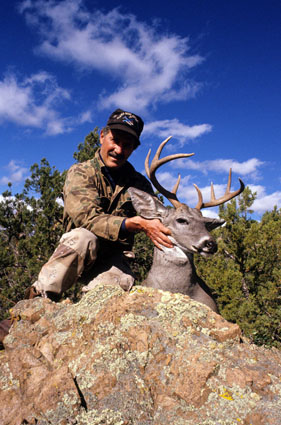 There’s more to life than the Midwestern whitetail rut, or even velvet-antlered mule deer for that matter. There are Northern late-season whitetail opportunities, no doubt, but they can also include brutal cold and battle-wise deer. Luckily for the hardcore bowhunter the West offers many prime late-season opportunities, sometimes in sunny settings.
There’s more to life than the Midwestern whitetail rut, or even velvet-antlered mule deer for that matter. There are Northern late-season whitetail opportunities, no doubt, but they can also include brutal cold and battle-wise deer. Luckily for the hardcore bowhunter the West offers many prime late-season opportunities, sometimes in sunny settings.
December Mule Deer: Nevada, Washington, Idaho, Utah
While early-season mule deer garner all the press, December hunt dates can also offer super bowhunting opportunities. This typically involves deer driven from high mountain areas by accumulating snow. The rut’s a distant memory, and crunchy snow can complicate stalking, but the monster antlers found in inaccessible early-season high country can actually prove more accessible. Nevada’s an obvious candidate for late-season mule deer opportunity, especially areas where snow drives deer from the High Sierras of California near Reno, out of southern Idaho and into accessible country surrounding Elko. Nevada tags include limited lottery tags, but can prove easily win. Places such as eastern Washington, southern Idaho, Utah and northern New Mexico are also worth a look.
Plains Mule Deer: Colorado
Plains mule deer offer another option. Colorado’s Eastern Plains includes December dates where bowhunters stalk behemoth muleys with not a mountain in sight. Nor should plains whitetail be ignored. This is a rare opportunity to successfully stalk whitetail at ground level, trophy quality on par with Midwestern holy grounds.
January Coues & Muleys: Arizona, New Mexico
January might seem an unlikely date to pursue a deer-hunting dream, but Arizona and New Mexico bowhunters do just that. This is rutting time close to the Mexican border, and also prime time for chasing elusive Coues whitetail. An archery Booner could be in the cards, but a 65-inch Pope & Young minimum Coues is also worth pursuing—a trophy many consider the hardest-won in bowhunting.
Public land is essentially unlimited and archery deer licenses easy to come by. Quality Arizona areas include national forests in the southwestern portion of the state; the Chiricahua, Dragoon, Whetstone, Patagonia, and Galiuro mountains, to name just a few. New Mexico archers look to the southern reaches of the Gila Wilderness and Blue Range, tight along the Arizona border, for Coues success.
Of course, southern Arizona and New Mexico mule deer attract their share of attention. Desert muleys are available to those willing to search more than stalk, traversing harsh, rugged country seeking scattered deer. Muleys are normally found at lower elevations than Coues whitetail; often well out into mesquite and greasewood flats, though New Mexico offers plenty of mountain habitats. Look for Arizona desert mule deer close to the Mexican border, in lonely desert wastes in the foothills of areas already mentioned. New Mexico late-season muley hotspots include the southwestern portions of the Gila National Forest, Jicarilla, Capitan, and Sacramento mountains farther east, to name but a few.
This is by no means a comprehensive list. There are many more late-season deer-hunting opportunities across the West. For those who believe the days between the whitetail rut and spring turkey are too darn many to endure, let this serve as an inspiration, motivating you to get out of the snow and cold this winter and extend your bowhunting season.






